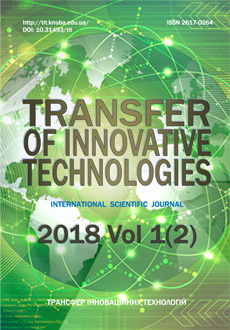Sustainable Tourism Development in Ukraine
DOI:
https://doi.org/10.31493/tit1812.0101Keywords:
types of tourism, natural and historico-cultural resources, territorial organization of ecotourismAbstract
The publication is a contribution within the framework of the United Nations Development Programmed project UKR/95/003 «Introduction of Sustainable Development Principles into Governmental Institutions». The objective of this project is to introduce sustainable development principles into the policies, programmed and planning activities of major Governmental institutions in Ukraine in accordance with: a) the priorities of the Government; b) the resolutions reached at international conferences in which Ukraine participated; c) the international conventions or agreements to which Ukraine is a signatory. The project which is implemented with UNDP resources, it is designed to stimulate a high-level policy dialogue on sustainable development issues in Ukraine and broaden participation in such a dialogue amongst Government institutions, as well as to disseminate the knowledge and tools necessary for the preliminary integration of sustainable development principles into the policy and strategy of the Government of Ukraine. The primary focus for ecological tourism in Ukraine is on recreational activity, however it is limited by the need to meet environmental protection demands. The legislative preconditions for ecotourism organization are stated in the laws "On the natural reserve fund of Ukraine" (1992), "On tourism" (1995), and “On resorts" (2000) [1, 2, 3]. This publication was prepared with the assistance of the National Commission on Sustainable Development under the Cabinet of Ministers of Ukraine.References
Law of Ukraine, On the nature reserve fund of Ukraine, 2004. Collection of legislative acts of Ukraine on protection of natural environment. Chernivtsi, Zelena Bukovyna, Vol.10, 26-39 (in Ukrainian).
Law of Ukraine, On tourism, 1995. Kyiv, Golos of Ukraine, No.2014 (in Ukrainian).
Law of Ukraine, On resorts, 2004. Collection of legislative acts of Ukraine on protection of natural environment. Chernivtsi, Zelena Bukovyna, Vol.10, 283-290 (in Ukrainian).
Panchenko T.F., 2009. Tourist Environment: architecture, nature, infrastructure. Kyiv, Logos, 176 (in Ukrainian).
Territory Planning Scheme, 2006. Coastal Zone of Black and Azov Seas for Application in Donetska, Zaporizka, Khersonska, Odeska, Mykolaivska Oblasts and the AR Crimea. Kyiv, DniproMisto, 230 (in Ukrainian).
Resolution, 1997. On amending the list of settlements attributed to resorts, No.1391. Kyiv, Cabinet of Ministers of Ukraine, 6 (in Ukrainian).
Town-planning. Reference book for the designer, 2006. Second Edition (ed. T.F.Panchenko). Kyiv, UkrArchBudInform, 192 (in Ukrainian).
Composition, contents, procedure of development, coordination and adoption of territory planning schemes (DBN B.1.1-6:2007), 2007. Kyiv, UkrArchBudInform, 9 (in Ukrainian).
Law of Ukraine. Оn the national formation program of the Ukraine ecological network 2000 − 2015 years, 2000. Vidomosti Verkhovnoi Rady Ukrainy, No.47 (in Ukrainian).
Law of Ukraine. On the Basic Principles (Strategy) of the State Environmental Policy of Ukraine for the period up to 2020, 2011. Vidomosti Verkhovnoi Rady Ukrainy, No.26 (in Ukrainian).
Golub A.A., 2017. Ecological and urban planning foundations of national parks formation. Abstract of a Thesis on Achieving of Degree of Doctor Philosophy in Architecture, Spec. 18.00.04 Urban planning and landscape architecture. Kyiv, 21 (in Ukrainian).
Rudenko L.G., Marunyak Ye.O., Golubtsov O.G., 2014. Landscape Planning in Ukraine (ed. L.G.Rudenko). Kyiv, Referant, 144 (in Ukrainian).
Methodical recommendations for recreational activities within the territories and objects of the nature reserve fund, 2009 (ed. G.V.Parchuk). Kyiv, 22 (in Ukrainian).
National Parks − National Heritage: Translated from English, 2008. EJournal USA (Ed. R. Gakkebi), Washington: Bureau of International Information Programs of the US Department of State, Vol.13, 55 (in Ukrainian).
Methodical recommendations for recreational activities within the territories and objects of the nature reserve fund, 2009. (ed. G.V. Parchuk). Kyiv, 22 (in Ukrainian).
Ustinova I.I., 2016. The Methodological Foundations of Sustainable Development of Ecological and City-Planning Systems. Abstract of a Thesis on Achieving of Degree of Doctor in Architectural Sciences, Spec. 18.00.01 Theory of Architecture, Restoration of Architectural Monuments. Kyiv, 46 (in Ukrainian).
Shulyk V.V., 2008. Methodological Foundations of recreational systems formation in Ukraine. Abstract of a Thesis on Achieving of Degree of Doctor in Architectural Sciences, Spec. 18.00.01 Theory of Architecture, Restoration of Architectural Monuments. Kyiv, 36 (in Ukrainian).
Alderman C. L., 1992. The Economics and the Role of Privately Owned Lands Used for Nature Tourism, Education and Conservation. Caracas, Venezuela: the IV-th World Congress on National Parks and Protected Areas.
Beaumont, Narelle K., 1993. Social Carrying Capacity of Green Island and Implications for Tourism/Recreation Planning and Management. Unpublished B. A. thesis, Department of Geography, James Cook University, Townsville, Australia.
Buckley, Ralf and John Pannell, 1990. Environmental Impacts of Tourism and Recreation in National Parks and Conservation Reserves. The Journal of Tourism Studies 1(1): 24-32.
World Resources Institute, World Conservation Union and United Nations Environment Programme, 1992. Global Biodiversity Strategy. Gland, Switzerland.
Skopen M.M., Sukach M.K., Budja O.P. etc., 2016. Information systems and technologies in the hotel-restaurant and tourist business: a textbook. Kyiv, Vyd-vo Lira-K, 764 (in Ukrainian).
Ustinova I.I., 2017. Fractality of concentric structures in space of ecologic-urban planning systems. Kyiv, KNUCA. Underwater Technologies, Vol.07, 87-95.
Downloads
How to Cite
Issue
Section
License
Copyright (c) 2020 Transfer of Innovative Technologies

This work is licensed under a Creative Commons Attribution-NonCommercial-NoDerivatives 4.0 International License.
Our journal abides by the CREATIVE COMMONS copyright rights and permissions for open access journals.
Authors, who are published in this journal, agree to the following conditions:
1. The authors reserve the right to authorship of the work and pass the first publication right of this work to the journal under the terms of a Creative Commons Attribution License, which allows others to freely distribute the published research with the obligatory reference to the authors of the original work and the first publication of the work in this journal.
2. The authors have the right to conclude separate supplement agreements that relate to non-exclusive work distribution in the form in which it has been published by the journal (for example, to upload the work to the online storage of the journal or publish it as part of a monograph), provided that the reference to the first publication of the work in this journal is included.




